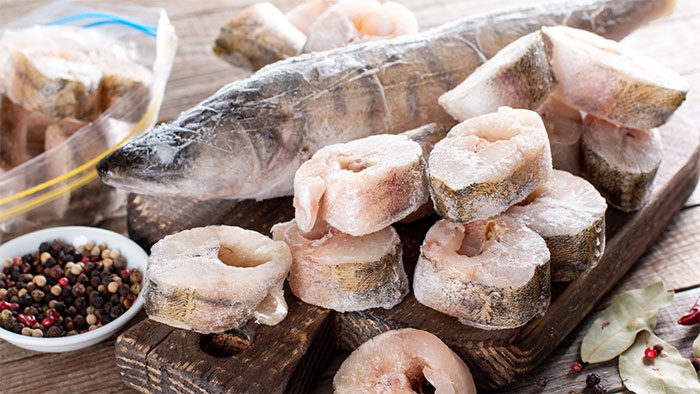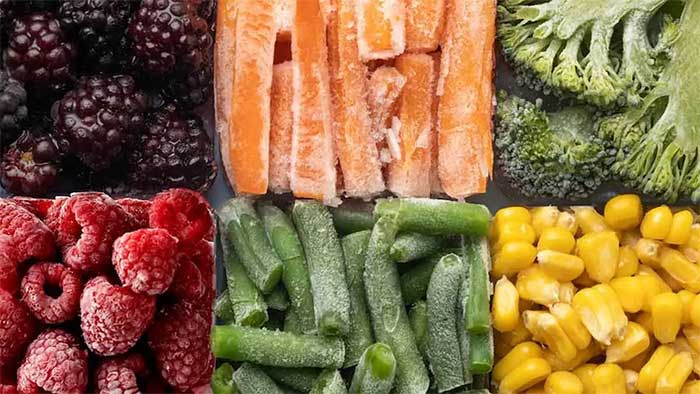Even though it is not yet the full moon of the last month of the lunar year, many families have started buying frozen foods to stock up in their freezers, anticipating that food prices will rise or that they will be too busy as the Lunar New Year approaches.
Buying Frozen Foods for Stockpiling Before the Lunar New Year: Important Considerations
Frozen foods like beef, vegetables, and more help many people save preparation time, store food longer, and maintain convenience while keeping most nutrients intact when frozen correctly. Here are some important tips to remember when purchasing and using frozen foods.
1. What Are Frozen Foods?
Simply put, frozen foods are products that have undergone a freezing process for long-term preservation. This method prevents the growth of microorganisms and slows down the enzymatic activity that causes food spoilage. By maintaining a temperature at or below 0°F (-18°C), the safety and nutritional integrity of the food are preserved until they are ready to be thawed and consumed.
Common frozen foods consumed worldwide include peas, french fries, beef, fish fillets, bread, pizza, sausages, chicken nuggets, and more.

Diverse and varied frozen foods. (Image: Internet).
Disadvantages of Frozen Foods
- Nutritional value may be lower compared to fresh foods due to dehydration, and some vitamins may diminish during the freezing process.
- Frozen foods are often processed and may contain additives, preservatives, or artificial flavors.
- There is a risk of health issues if the food is not handled or cooked properly before consumption.
- Frozen foods may lose their natural flavor and experience texture changes after thawing.
- While convenience is a factor, it can lead to increased consumption of processed foods, resulting in a less balanced diet.
2. Key Tips to Remember When Buying Frozen Foods
Don’t Overlook Expiration Dates
When purchasing frozen foods from a store, besides checking the ingredient list for excess additives or potential allergens, the expiration date of the product is something you need to pay special attention to.
The product packaging will indicate the expiration date and the best before date, which is the time when the food is at its best quality and flavor before declining.
If you’re freezing food yourself, the shelf life of frozen foods, if properly prepared, packaged, and sealed, is as follows:
- Fruits, vegetables, and baking ingredients: 8 – 12 months
- Poultry: 6 – 9 months
- Fish: 3 – 6 months
- Ground meat: 3 – 4 months
- Cured meat: 1 – 2 months
- Pre-packaged or ready-to-eat frozen products: 1 – 2 months.
Additionally, you should label and categorize old/new foods for convenience. Organizing food to store in different freezer compartments also helps reduce the risk of cross-contamination.

The product packaging will indicate the expiration date and the best before date, which is the time when the food is at its best quality and flavor before declining (Image: Internet).
Check Product Packaging
If the packaging is torn or cracked, the frozen product is at risk for freezer burn (a phenomenon that occurs when food dries out), potential bacterial contamination, and may not be safe to continue freezing or consuming. Therefore, it’s important to check the packaging for any signs of tearing, puncturing, or resealing when purchasing pre-packaged foods.
Read Ingredient Labels Carefully
A long ingredient list often indicates the presence of unnecessary additives and preservatives. Prioritize products with short, simple ingredient lists that resemble what you typically use when cooking at home.
Buy a Moderate Amount of Frozen Foods
Buying a large quantity of frozen foods for storage without enough appropriate storage space can lead to improper freezing, increasing the risk of freezer burn, negatively affecting the flavor and texture of the food.
Other Considerations
- Avoid selecting frozen foods with packaging or products that appear wet or seem to have been thawed and refrozen.
- When purchasing frozen foods, keep them in insulated bags during transport and get them back into your freezer as soon as possible.
- Ensure the freezer temperature aligns with the guidelines on the product packaging. Make sure the temperature of the freezer is accurate. Most freezers or refrigerator freezer compartments can be adjusted. According to FDA recommendations, the appropriate temperature for the freezer is -18 degrees Celsius.
3. Foods You Should Not Freeze
In addition to buying pre-frozen foods, many families also prepare and freeze their own food. However, not all foods should be stored in the freezer. Fresh vegetables like lettuce, cucumbers, and others that are high in water content tend to have their cells burst and spoil, resulting in a soggy texture when thawed. Soft cheeses and whole eggs can also easily crack or explode when stored in the freezer.

Not all foods should be frozen. (Image: Internet).
Here are some foods that should not be stored in the freezer due to potential loss of flavor, reduced nutritional value, structural changes, or spoilage:
- Most dairy products
- Potatoes
- Whole eggs
- Fried foods and pastries
- Soft cheeses
- Fresh fruits and vegetables high in water content
- Foods that have been thawed once
- Cashew-based sauces
- Pasta
- Cooked rice
- Garlic, cloves, and pepper may lose flavor and potency when frozen
- Mayonnaise
- Carbonated beverages
- Coffee.
4. Tips for Preparing Frozen Foods
When preparing frozen foods taken from the freezer, you should pay attention to:
Look for Color Changes
Many types of food change color when frozen for extended periods— for example, raw beef may turn from red to brown, or fresh chicken may turn white. This does not necessarily mean the food is unsafe to eat, but it indicates that the food may not have the original flavor you expect.
Beware of Freezer Burn
Freezer burn occurs when food is improperly stored in the freezer, causing moisture to escape and forming ice crystals. Although the food is still edible, this ice layer can “burn” the food, resulting in a drier texture and less flavor.
To avoid freezer burn on frozen foods, you should remove as much air as possible when storing the food. Specialized freezer bags may offer more advantages than regular food containers.
Proper Thawing Methods
Use the refrigerator to thaw food overnight or utilize the microwave’s defrost setting if you need to thaw quickly.

Use the refrigerator to thaw food overnight or utilize the microwave’s defrost setting if you need to thaw quickly. (Image: Internet).
- Avoid leaving frozen food at room temperature for too long as it can lead to rapid bacterial growth.
- Cook frozen food at a safe temperature to ensure harmful bacteria are killed.
- Do not refreeze thawed food if you have not cooked it completely, as this can increase the risk of foodborne illness.
- Be cautious with the amount of salt and fat if you are using frozen food that has been pre-seasoned or processed.
5. Frequently Asked Questions
Is it safe to eat frozen food past its expiration date?
According to guidelines from the U.S. Food and Drug Administration (FDA), frozen food stored at a continuous temperature of 0°F or lower can be safe indefinitely; however, quality and flavor may diminish after the “best by” date.
Is it safe to cook frozen meat without thawing it first?
Generally, cooking frozen meat without thawing is safe, although the cooking time may be about 50% longer than for thawed meat. Always ensure that the final cooking temperature meets food safety guidelines.
Is frozen food less nutritious than fresh food?
Proper freezing actually helps preserve nutrients in food, especially in fruits and vegetables that may lose or degrade nutrients when stored fresh for extended periods. Of course, if possible, you should consume fresh food to receive maximum health benefits immediately.
In summary, buying and storing frozen food correctly is crucial to ensure the safety and quality of the food. Consumers should carefully select products, avoiding packages that show signs of having thawed and refrozen. Using insulated bags and placing food in the freezer immediately will help keep food cold and prevent bacterial growth. Finally, pay attention to reheating and cooking food carefully to ensure it is cooked and safe for health.
These tips not only help protect your health and that of your family but also allow you to fully enjoy the flavors of food without encountering unnecessary risks.


















































